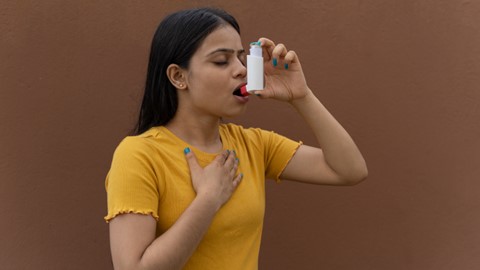Chronic obstructive pulmonary disease (COPD) is a common progressive lung disease that causes the lungs to become inflamed, damaged, and narrowed, making it hard for the person to breathe.
COPD Stages:
• Emphysema (damage to the lungs over time)
• Chronic bronchitis (long-term cough with mucus due to inflammation)
Most people with COPD have a combination of both conditions. COPD causes airflow blockage and breathing-related problems.
With COPD, less air flows through the airways (tubes that carry air to your lungs). This could be due to the following:
• The lungs lose their ability to pump
• The walls between the air sacs of the lungs are destroyed
• The walls of the airways become thick and swollen
• The airways make more mucus that clogs and blocks airflow
COPD Symptoms
The main symptoms of COPD include:
• Increased breathlessness (especially during physical activity)
• Persistent cough with phlegm
• Frequent chest infections
• Persistent wheezing
• Chest Tightness
• Swelling of ankles, feet, or legs
Symptoms usually get progressively worse if left untreated. COPD may also get suddenly worse, known as flare-up or exacerbation.
COPD Causes
The leading cause of COPD is smoking.
It can also affect people who have never smoked, but the likelihood of developing COPD is more in people who smoke.
Other causes include:
• Long-term exposure to dust and fumes
• Rare genetic problems
• Air Pollution
• People with asthma
Diagnosis and Tests to Detect COPD
Your doctor will check your symptoms, medical history, and if you smoke or have been exposed to chemicals or dust. A physical examination and breathing tests are performed.
The most common test is spirometry (to measure the air your lungs can hold and how fast you can blow air out).
Other tests:
• Chest X-rays to rule out emphysema and other lung problems
• CT scan to help the doctor confirm the diagnosis
• Arterial blood gas test to measure the lungs’ capacity
Let your doctor know if you have a persistent cough that does not go away.
COPD Treatment
There is no cure for COPD.
The goal of treatment is to-
• Ease symptoms
• Slow the disease progression
• Prevent or treat any complications
• Improve overall quality of life
The best thing to stop the progression of COPD is to stop smoking.
Talk to your doctor about the best treatment options for you.
COPD Prevention
Although there is no cure for COPD, there are ways to stay healthy, ease your symptoms, and enhance your quality of life.
• Quit Smoking
• Avoid Secondhand Smoke
• Avoid High Exposure to Air Pollution
• Avoid Exposure to Irritant Chemicals and Fumes
A family history of COPD can increase your chance of getting COPD.
Living with COPD: Preventive Measures
People with COPD require lifelong management of the disease. This includes the doctor’s treatment and maintaining a healthy lifestyle.
In people with COPD, the lungs are weak, so it is essential to adjust their lifestyle to avoid a flare-up of the disease.
Some essential things that are required to follow include:
• Avoid smoking (talk to a doctor about smoking cessation programs)
• Avoid secondhand smoke, fumes, chemical exposure, air pollution, and dust
• Exercise daily to help you stay strong and increase your immunity.
• Physiotherapy for COPD patients help improve quality of life.
• Avoid highly processed foods loaded with calories and salt.
• Manage other chronic diseases (diabetes and heart disease) and COPD.
• Take precautions in doing household tasks.
Contact your doctor immediately if you have any flare-ups.
COPD and Vaccinations
People with COPD are at a greater risk of developing severe health problems from certain vaccine-preventable diseases.
Vaccinations protect against conditions like flu or influenza and pneumococcal diseases.
These two can lead to serious respiratory illnesses, even if the condition is mild and symptoms are controlled.
Talk to your doctor about getting vaccinated and ways to manage the disease.
COPD and Lung Cancer: Are You at Risk?
COPD and lung cancer are the primary health conditions linked with several common risk factors.
Smoking is the primary risk factor; secondhand smoke or exposure to chemicals or other fumes comes next.
Genetic predisposition and age are also risk factors for developing both diseases.
About 40-70% of people with lung cancer also have COPD, which concludes that COPD can be a driving factor in lung cancer.
However, having COPD does not necessarily mean you will get lung cancer in the future.
Myths and Facts
Myth: Only Smokers Develop COPD
Fact: Although smoking is the leading cause of COPD, there are many other risk factors, including-
• Air pollution
• Work-related pollution
• Infection
• Asthma
• Family history
The best thing to prevent COPD is to STOP SMOKING.
Conclusion
Chronic Obstructive Pulmonary Disease (COPD) is a chronic lung condition that affects millions of people around the world. It is caused by long-term exposure to irritants such as cigarette smoke, air pollution, and dust. COPD can cause significant respiratory symptoms such as shortness of breath, coughing, and wheezing, and it can significantly impact a person’s quality of life. While there is no cure for COPD, there are many treatment options available to help manage symptoms and slow the progression of the disease. With proper management, people with COPD can lead fulfilling lives and enjoy activities they love.

